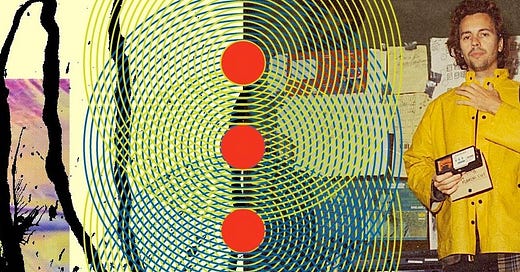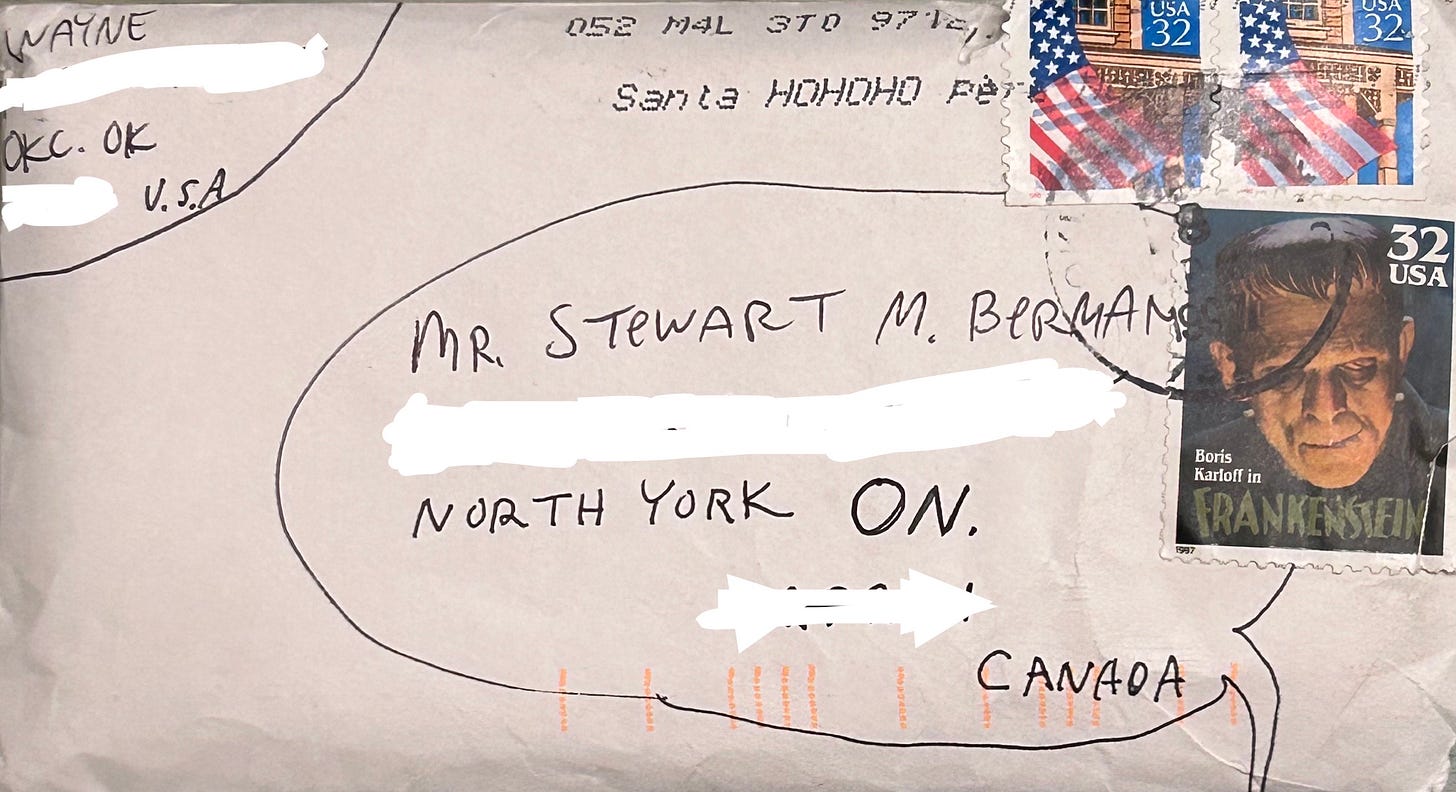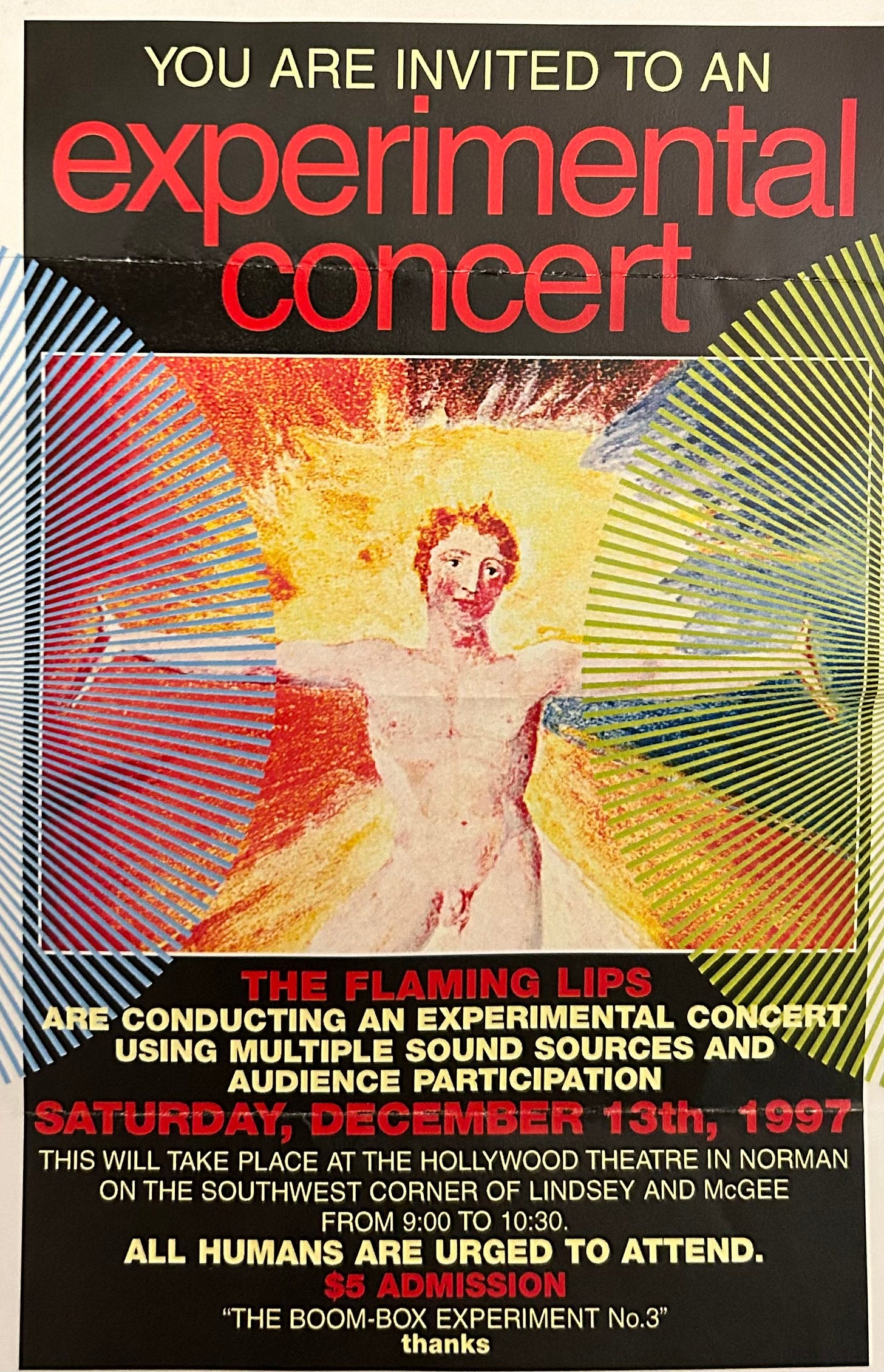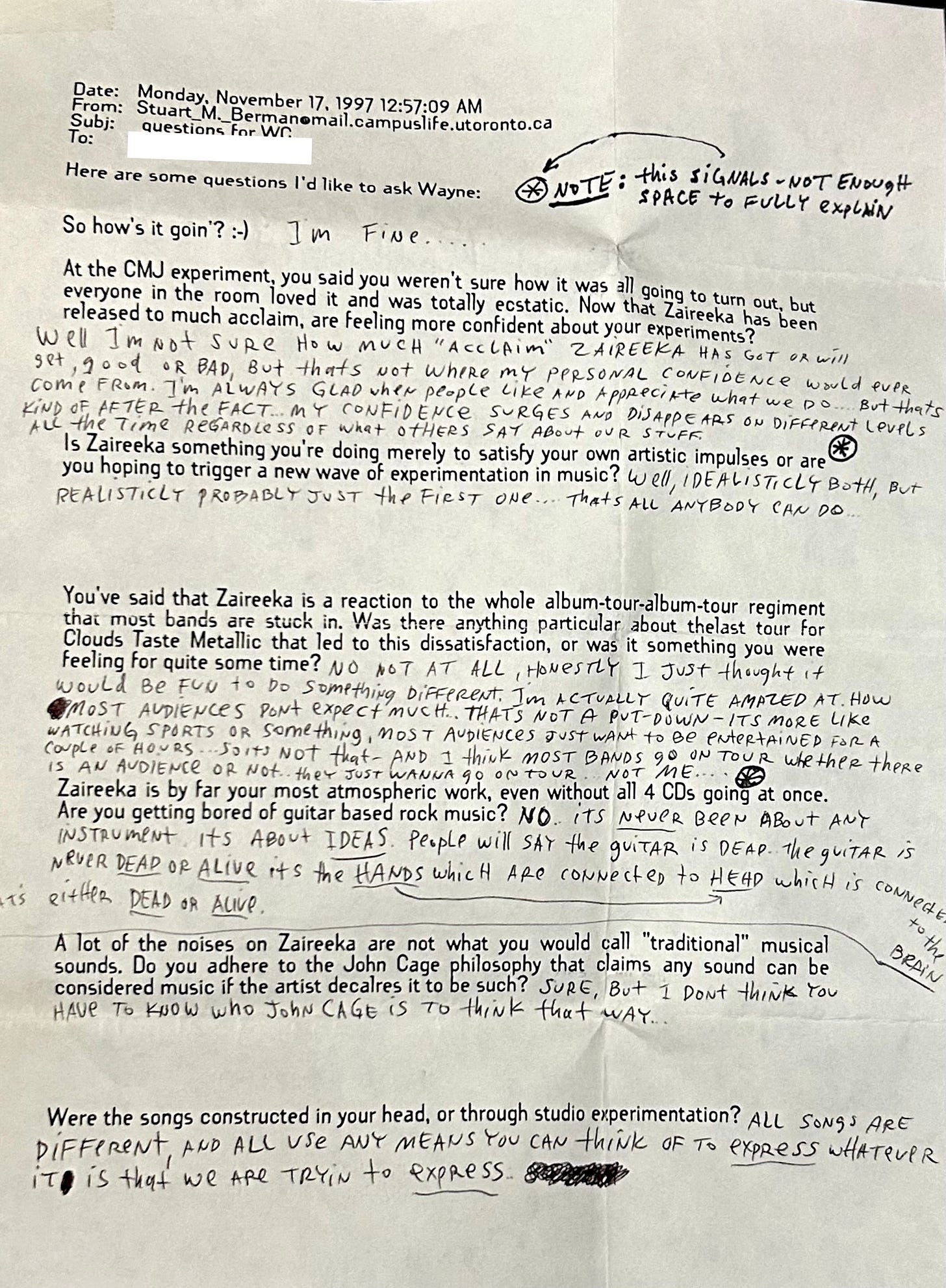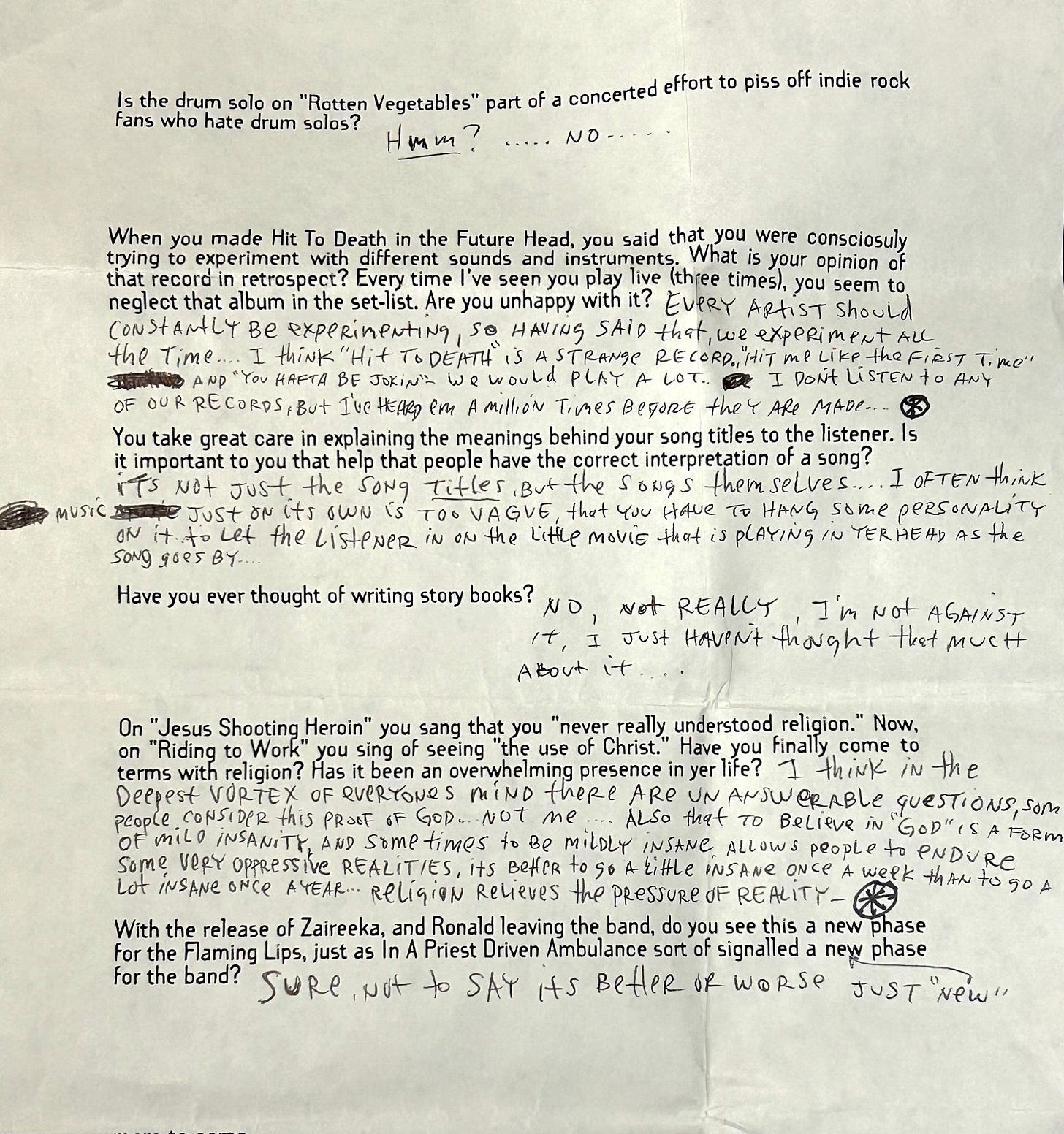A correspondence with Wayne Coyne from 1997
That time I emailed the Flaming Lips leader some interview questions... and he sent back handwritten responses via snail mail
Welcome to stübermania, where I dig into my box of dust-covered interview cassettes from the ‘90s and ‘00s and present bygone conversations with your favourite alterna/indie semi-stars. This is a newsletter in three parts: The Openers (links to recent writings, playlist updates, and/or other musical musings), The Headliner (your featured interview of the week), and Encores (random yet related links).
This is a free newsletter, but if you really like what you see, please pay a visit to my PWYC tip jar!
THE OPENER
I’ve been unsuccessful in my attempts to land a 20th-anniversary retrospective piece on The Futureheads’ eternally awesome self-titled debut album this month, so I’ve opted to drown my sorrows in “Quality Pints,” the recent single from equally zippy Welsh garage-punks The Bug Club, whose highly replayble new album, On the Intricate Inner Workings of the System, drops August 30 on Sub Pop. That song leads this week’s update of the stübermania 2024 playlist, alongside some prime Stereolabica from Peel Dream Magazine, the slow-burn fury of Cleveland funk mystics Mourning [A] BLKstar, a righteous MC5 cover from roots-rocker Carson McHone, a fragile-yet-fantastical epic from ex-Goat Girl bassist Naima Bock that sounds like something on Blocks Recording Club circa 2006, and fresh fuzz-pop thrills from ‘90s Buzz Bin survivor John Davis of Superdrag.
Click on the image below to hear the Apple Music version of the playlist:
Speaking of all-timer albums celebrating a milestone anniversary this month that I wasn’t able to properly commemorate in print: Happy 20th birthday to this beast.
THE HEADLINER
A correspondence with Wayne Coyne from 1997
Date: December 8, 1997
Location: my mailbox
Publication: The Varsity
Album being promoted: Zaireeka
The context: If you have any familiarity with my writing, then you know that I hold a deep affection for The Flaming Lips. As of this newsletter’s publication, there are 20 Flaming Lips album reviews archived at Pitchfork and I wrote 11 of them (not including side projects). I’ve retained my enthusiasm for this band long after many fans I know grew tired of their highly choreographed, confetti-strewn stage spectacles, or tuned out of their post-Yoshimi discography, or got turned off by their various dramas. But despite their occasional missteps, I’ve never lost my faith in the Lips’ ability to produce weird and wonderful music—and, at least once per decade, they’ll drop a masterwork like Embryonic or American Head to reward your commitment.
If you put a watermelon gun to my head, I would call The Flaming Lips my favourite band of all time, in large part because they were a group I fell in love with on my own volition, without any prompting. Their records weren’t handed down to me by my older brother, and I wasn’t instructed to check them out by a magazine or college-radio DJ or record-store clerk. In June of 1993, I saw them open a Porno for Pyros show at Toronto’s Concert Hall, completely unaware of who they were, and they blew the headliner off the stage—and my mind wide open—with a sensory-overloading onslaught of dry ice, strobe lights, and projections of dancing naked hippies. This was about two years before “She Don’t Use Jelly” turned them into Steve Sanders’ new favourite band, and finding any information about the Lips back then was difficult—at this point, they weren’t getting a ton of ink in music mags, and there wasn’t really an internet to turn to (and even if there was, I didn’t even have a home computer to access it). But a few days after that Concert Hall show, I found a cheap used copy of Hit to Death in the Future Head (a.k.a. the album that gave the aforementioned Futureheads their name) at Incredible Records on Yonge Street, and I’ve been wearing the proverbial bunny suit ever since.
The Flaming Lips of 1993 were the perfect bridge between the comforting classic-rock I grew up on and the noisy indie-rock I was getting into, but four years and one fluke MTV hit after our first encounter, the band had grown tired of the standard guitar/bass/drums format. They spent much of 1997 devising these elaborate, interactive sound experiments where they distributed cassettes to attendees and instructed them to hit “play” on a boombox (or, in the case of their SXSW parking-garage gathering, a car stereo) at the same time, while frontman Wayne Coyne, bassist Michael Ivins, and drummer Steven Drozd “conducted” the crowd to raise or lower the volume at strategic points—and from that chaotic soundclash, a proper song would magically form as all the discrete elements coalesced. (I was at the 1997 CMJ event at Avery Fisher Hall, where we were treated to a boomboxed preview of “The Big Ol’ Bug Is the New Baby Now.”)
That fall, The Flaming Lips released Zaireeka, which was sort of like the play-at-home version of these cassette experiments—it was a four-CD set, but the discs were meant to be played simultaneously, not sequentially. (Rather than contort yourself into a human pretzel to pull it off on your own, you were supposed to get three of your friends together with your portable stereos and make it like a Wizard of Oz/Dark Side of the Moon group ritual.) I was writing for The Varsity student newspaper at the University of Toronto, and I was eager to set up an interview with the band to talk about the project, but the Lips’ usual Canadian distributor, Warner Music Canada, wasn’t doing an official domestic release north of the border, and therefore wasn’t fielding any promo requests for the album. But after buying a copy of Zaireeka on import for $50 (approximately $10 million in 2024 dollars) at the Yonge Street Sam the Record Man, a non-publicist friend at the label (thank you, Catskillz!) looped me in on an email with the band’s manager, Scott Booker, who said he’d hook me up with a phone interview with Wayne Coyne.
After a few weeks, I followed up with Scott, who then asked me something I had never encountered before when setting up an interview: “can you send me the questions over email?” I was kind of taken aback—not because I felt torn about the journalistic ethics of revealing your questions to your subject in advance; rather, I just felt completely self-conscious about exposing my thought process in this way. Ideally, you want interviews to feel like natural conversations rather than rigid questionnaires, whereas the email format forced me to articulate myself in ways that can read a bit awkward on paper. Since then, of course, I’ve done a ton of interviews over email, and in some ways they’re preferable—hey: no transcribing required!—but at the time, I felt like I was being asked to audition for an acting role. My misgivings were confirmed when, upon emailing Scott the questions, he fired back a message saying something along the lines of: “Buddy, you think about this band way too much…” (Guilty as charged.)
And then… nothing. Weeks went by with no email response, and I felt a little too sheepish to nag Scott about it anymore, so I had all but given up on the interview… until one day in December, Scott emails me back to ask for my address, and then a few days later, I get this letter in the mail with a Frankenstein stamp, some familiar handwriting, and an Oklahoma City return address.
The first thing I see when I crack open the letter is this flyer:
And tucked behind that were three folded-up pieces of paper joined together in the top corner by a piece of Scotch tape serving as an ad-hoc staple. And on the papers were the original questions I had emailed to Scott, printed and spaced out to provide sufficient room for Wayne Coyne to write in his answers by hand.
To this day, I’m still amazed that Wayne took the time and effort to do that, and this letter remains the first thing I’ll reach for if my home is burning down (okay, maybe the third, after my children and cats). So thank you, Wayne, for going way above and beyond for an over-eager campus-newspaper writer, and for humoring some of my stupider questions.
ENCORES
Out of curiosity, I punched the return address on the letter above into Google Street View to get a glimpse of Coyne’s famed Oklahoma City compound, and I spotted someone familiar on the sidewalk out front.
Yes, my email address in 1997 was actually Stuart_M._Berman@mail.campuslife.utoronto.ca. (Case-sensitive, of course.) When I retired it two years later in favour of a Yahoo account, all the preferred variations on my name were already taken, so I went with the slightly less cumbersome godshowmemagic@yahoo.ca in honour of the Super Furry Animals (i.e., The Flaming Lips of Wales).
For more Lips lore, here’s a piece I wrote for Stereogum last year (to mark the band’s 40th anniversary) where I list off my 10 favourite Lips obscurities.
The main reason I dug out this particular interview for this week’s newsletter is that I went to see the Lips perform (my 25th time, for those keeping score) this past Monday at one of my favourite outdoor venues, the Artpark in Lewiston, New York (which is located so close to the Canada/U.S. border, it may as well have a duty-free shop). The show was divided into two sets: a complete run-through of Yoshimi Battles the Pink Robots, and then a well-curated second hour of obvious hits, Soft Bulletin album tracks, rarities (At War With the Mystics B-sides included), and at least one tune inspired by Kacey Musgraves taking acid. Certain elements of the Lips’ stage show have changed over the years—the inflatibles are bigger and there’s much less confetti being shot off (much to the relief of grounds crews everywhere, I’m sure), and while Coyne will still hop into his plastic bubble, he seems less eager to roll out for a crowd-surf (which I’m totally fine with—I’d rather see the band play more songs than spend several minutes waiting for their singer to bounce his way back onstage). I’m also still getting used to the sight of Coyne and Drozd onstage without Ivins. But I was very happy to see that the Mystics deep cut “Pompeii am Götterdämmerung” has retained its rightful place as a setlist standard.
Next week’s headliner: Stephen Malkmus
This is a free newsletter, but if you really like what you see, please pay a visit to my PWYC tip jar!


